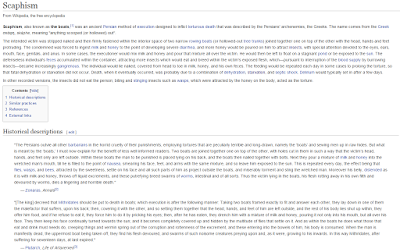First let's take a look at the definition of torture.
"Torture is the act of deliberately inflicting severe physical or psychological pain and possibly injury to an organism, usually to one who is physically restrained or otherwise under the torturer's control or custody and unable to defend against what is being done to him or her. Torture has been carried out or sanctioned by individuals, groups, and states throughout history from ancient times to modern day, and forms of torture can vary greatly in duration from only a few minutes to several days or even longer.
Reasons for torture can include punishment, revenge, political re-education, deterrence, interrogation or coercion of the victim or a third party, or simply the sadistic gratification of those carrying out or observing the torture. The need to torture another is thought to be the result of internal psychological pressure in the psyche of the torturer. The torturer may or may not intend to kill or injure the victim, but sometimes torture is deliberately fatal and can precede a murder or serve as a form of capital punishment. In other cases, the torturer may be indifferent to the condition of the victim. Alternatively, some forms of torture are designed to inflict psychological pain or leave as little physical injury or evidence as possible while achieving the same psychological devastation. Depending on the aim, even a form of torture that is intentionally fatal may be prolonged to allow the victim to suffer as long as possible (such as half-hanging).
Although torture was sanctioned by some states historically, it is prohibited under international law and the domestic laws of most countries, as developed in the mid-20th century. It is considered to be a violation of human rights, and is declared to be unacceptable by Article 5 of the UN Universal Declaration of Human Rights. Signatories of the Geneva Conventions of 1949 and the Additional Protocols I and II of 8 June 1977 officially agree not to torture captured persons in armed conflicts, whether international or internal. Torture is also prohibited by the United Nations Convention Against Torture, which has been ratified by 158 countries. Although torture is universally condemned by all democratic nations, there have been many suspected or known instances of its sanctioned use - regardless of its legality. An example of this is the use of euphemistically-named enhanced interrogation techniques including water-boarding, known to have been used by the United States after the September 11 attacks."
I don't think I want to look too much at modern methods of torture, these modern methods are more psychological and human driven rather than using an actual item to inflict the work, and when an item is used it's derived from an old age device. I find the ancient torture devices more visually appealing for this kind of work and I feel will be more recognisable to an audience. It would also be hard to make something visual out of something that is completely all in the mind, I'm not sure if I have the skills enough to characterise something like white room torture.
There are different categories of torture devices (psychological and physical) so I have listed the information here by what the two types.
Psychological.
Physical.
I have also collected several images of different torture devices to create some mood boards.
Who knew there were so many different ways to hurt another person, really makes you think about the mentality of those who do such things.

























No comments:
Post a Comment